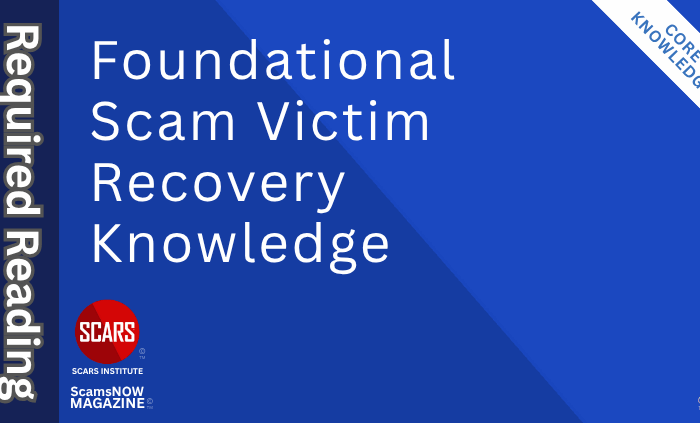
Physiological Effects of Repressing Healthy Anger and Tolerating Unhealthy Anger in Traumatized Scam Victims
Somatic Effects of Anger on the Scam Victim’s Body
Primary Category: Psychology / Scam Victim Health
Author:
• Vianey Gonzalez B.Sc(Psych) – Licensed Psychologist, Specialty in Crime Victim Trauma Therapy, Neuropsychologist, Certified Deception Professional, Psychology Advisory Panel & Director of the Society of Citizens Against Relationship Scams Inc.
• Tim McGuinness, Ph.D., DFin, MCPO, MAnth – Anthropologist, Scientist, Polymath, Director of the Society of Citizens Against Relationship Scams Inc.
Author Biographies Below
About This Article
After a relationship scam, anger often sits beside shock and grief, and your body carries the load when healthy anger is pushed down or unhealthy anger is tolerated. Repressed anger keeps the stress response active, which may raise blood pressure, tighten muscles, upset digestion, weaken immunity, disturb sleep, and slow thinking. Repeated exposure to hostile outbursts can produce similar strain, adding headaches, chest tightness, and inflammation as allostatic load builds over time. Helpful steps are simple and steady: lengthen the exhale, soften the jaw and shoulders, take a brief walk after stress, create an evening wind-down, write one plain line in a notebook or journal, and use short boundary statements that lower exposure to harm. Healthy anger can become clear information and action, while unhealthy anger can be held at a safer distance. If symptoms persist or escalate, medical care may help you protect your health while recovery continues with patience, skill, and support.
Note: This article is intended for informational purposes and does not replace professional medical advice. If you are experiencing distress, please consult a qualified mental health professional.
The information in this section is educational, and it does not replace medical care. If you notice any of these symptoms or conditions, contact your medical doctor right away, or seek urgent or emergency care if your symptoms are severe. Only a licensed clinician can evaluate, diagnose, and treat medical issues, and timely care may prevent complications.

Physiological Effects of Repressing Healthy Anger and Tolerating Unhealthy Anger in Traumatized Scam Victims
The Basics
Repressing Healthy Anger
Repressing or suppressing healthy anger, which is a natural response to threats or injustices, can lead to a buildup of internal stress. This often manifests in various physiological effects due to prolonged activation of the body’s stress response without resolution. Common effects include:
-
- Cardiovascular issues: Increased risk of high blood pressure and potential long-term heart problems from chronic tension.
- Musculoskeletal problems: Muscle tension, chronic pain, and headaches from stored emotional energy.
- Digestive disturbances: Issues like nausea, indigestion, stomach problems, or chronic cough as psychosomatic symptoms.
- Immune system weakening: Reduced immunity due to elevated cortisol and inflammation from ongoing stress.
- Other effects: Heightened pain sensitivity, lethargy, and potential links to anxiety or depression through autonomic nervous system changes.
These effects stem from the body’s fight-or-flight response being triggered repeatedly without an outlet, leading to accumulated physical strain. See below for a more detailed list.
Tolerating Unhealthy Anger
Tolerating unhealthy anger can refer to either enduring chronic, destructive anger from oneself (unmanaged or explosive) or putting up with it from others, such as in abusive relationships. In both cases, it often results in sustained physiological arousal or chronic stress. Key effects include:
-
- Cardiovascular strain: Elevated heart rate, high blood pressure, and increased risk of heart disease from repeated adrenaline surges.
- Stress-related issues: Heightened cortisol levels leading to chronic stress, muscle tension, and headaches.
- Immune suppression: Weakened immune function, making the body more susceptible to illnesses.
- Mental health overlaps with physical: Links to anxiety, depression, and substance use, which can exacerbate physical symptoms like fatigue or impaired performance.
- When tolerating from others (e.g., emotional abuse): Psychological stress causing health impairments, loss of motivation, and potential for trauma-related physical effects like digestive issues or chronic pain from prolonged fear and anxiety.
Unmanaged anger keeps the body in a state of high alertness, while enduring it from others triggers similar stress responses as victimization, often leading to overlapping outcomes like inflammation or impaired cognitive function. See below for a more detailed list.
Looking Deeper
After betrayal by a scam, anger often rises alongside shock, grief, and fear. The anger may feel unsafe, so it gets pushed down. In other moments, unhealthy anger from others may be tolerated because conflict feels risky or because shame makes pushback feel impossible. Both patterns carry physical costs. The body runs chemistry for danger while daily life asks for calm, and that mismatch can strain the heart, the muscles, the gut, the immune system, and sleep. Understanding how anger operates in the body gives you language to make steadier choices. Healthy anger can become information and action, while unhealthy anger can be limited with clearer boundaries and safer support.
Anger is a survival signal. When a wrongdoing threatens safety, the sympathetic nervous system prepares you to respond. Heart rate climbs, breathing quickens, muscles tense, and stress hormones surge. This response helps in short bursts. When anger is repressed for long periods or when unhealthy anger is tolerated for long periods, the same chemistry repeats without resolution. Over time, repeated surges can build into what researchers call allostatic load, which is the wear and tear from chronic stress. The goal is not to remove anger. The goal is to let healthy anger move in safe ways, and to reduce exposure to unhealthy anger that keeps the system on high alert.
Repressing Healthy Anger
Healthy anger says a boundary was crossed. When that message gets blocked, the body still carries the energy for action with nowhere to send it. The result often looks like long tension in the shoulders and jaw, shallow breathing, headaches, stomach tightness, and poor sleep. These signals are not weaknesses. They are the body’s way of asking for a safer route to express a true message.
Cardiovascular strain can develop when anger stays inside. Elevated blood pressure, faster resting pulse, and stress-related palpitations may appear during the day or in the evening when the mind revisits events. Research links unexpressed or hostile anger styles to higher risks for hypertension and coronary disease over time. Short, safe expressions of anger can bring heart rate back toward baseline more quickly. Activity that raises the heart in a planned way, like a brisk walk, may also help the system complete a stress cycle.
Musculoskeletal pain often follows repression. Muscles prepare for action and then hold that readiness. Neck pain, back tightness, tension headaches, and jaw clenching are common. When anger cannot be named, posture may close in and breathing may shrink, which adds more strain to the same areas. Gentle movement and slow, longer exhales can release some of this stored effort. Naming the anger out loud in simple words can reduce the need for the body to carry the whole message.
Digestive disturbances are frequent. The gut responds to stress chemistry and changes how it moves and digests. Nausea, heartburn, indigestion, and irritable bowel symptoms can flare when anger rises and then gets shut down. A regular meal schedule, slower eating, and brief pauses before and after meals can help the gut settle. Speaking one true line about what upset you may lower gut reactivity over time, because the body no longer has to hold all of the tension by itself.
Immune function can weaken under chronic repression. Stress hormones like cortisol can alter immune responses and increase inflammation. People often report more colds, slower healing, or flare-ups of inflammatory conditions during long periods of unspoken anger. Basic care, such as consistent sleep, gentle activity, hydration, and balanced meals, supports immunity. Finding a safe person or a private practice where anger can be expressed in words adds another layer of protection.
Pain sensitivity can rise when anger stays silent. The nervous system becomes more reactive, and ordinary sensations can feel sharper. Sleep often suffers as well, which lowers pain tolerance further. A steady wind-down routine, dimmer light in the evening, and shorter screens near bedtime may improve sleep enough to reduce overall pain. Writing a brief note in a notebook or journal about the day’s anger before bed can help the brain file the experience and settle.
Mood can sink when healthy anger has no outlet. Anxiety and depression may gain ground, not because anger is wrong, but because the body is working hard without relief. The autonomic nervous system becomes unbalanced, and attention narrows. Gentle self-talk, such as this anger is information, not a danger can calm the system. A short conversation with someone who validates your experience can restore perspective and ease the load.
Tolerating Unhealthy Anger
Unhealthy anger arrives as intimidation, contempt, threats, cruel sarcasm, or repeated outbursts. This anger may come from others or from your own inner voice when shame takes the wheel. The body reads unhealthy anger as danger and prepares to defend, flee, or freeze. When exposure repeats, stress chemistry can become a daily baseline, and the same physical systems begin to wear down.
The heart and vessels carry much of the burden. Adrenaline and norepinephrine surge during each episode, raising heart rate and blood pressure. If these episodes repeat weekly or daily, the cardiovascular system adapts in ways that increase long-term risk. Quiet time after episodes helps, yet prevention helps more. Reducing exposure to unhealthy anger, even in small increments, may lower overall cardiovascular strain.
Stress headaches and muscle pain often follow exposure. The shoulders lift, the jaw tightens, and the lower back braces. These responses make sense. They are protective. They also become patterns that cause pain of their own. Heat, stretching, and mindful relaxation can help, as can short, safe movement that restores a sense of control. A single supportive sentence from a trusted person can relax the face and neck more than a long explanation, because safety, not logic, turns tension down.
The immune system can falter under ongoing intimidation. Studies connect long stress exposure with higher inflammation and weaker antiviral defenses. People report more frequent minor illnesses and longer recoveries. Gentle routines that support sleep and nutrition matter here. A quieter environment during rest, fewer stimulants late in the day, and a predictable bedtime can restore some balance. Reducing exposure to unhealthy anger, where possible, protects the immune system best.
The gut reacts strongly to hostility. The brain and the digestive tract communicate through nerves and hormones, so fear and anger can alter motility and sensitivity. Bloating, cramps, constipation, or diarrhea may appear during tense periods, then lighten when safety returns. Calm, simple meals, sips of water throughout the day, and short post-meal walks can support the gut. Putting words to what happened helps too, because your system stops holding unspoken shock.
Cognition may slow after exposure to unhealthy anger. Attention narrows, memory stutters, and decision-making feels harder. This is a normal shift under stress chemistry. Brief grounding exercises and short lists can keep the day moving when the brain feels foggy. Kind language toward yourself matters as well. Harsh self-anger adds a second layer of threat and often makes fog thicker.
When unhealthy anger comes from loved ones, the body pays a double price. Attachment seeks connection while threat signals urge distance. That push and pull tires the nervous system and can lead to exhaustion and sleep disruption. Short, predictable check-ins with safe people outside the conflict can restore the sense that connection is possible and safe. Over time, your body learns again that calm contact is available.
How Healthy Anger Protects the Body
Healthy anger serves stability. It points to a crossed line and asks for change. When expressed clearly and safely, it tends to rise and fall rather than simmer. That shape protects the body. Heart rate returns toward baseline, muscles release, and the stress system stands down. The goal is not to vent. The goal is to deliver a message that reduces the need for the body to be in constant readiness.
Language helps. Short, specific lines such as I felt dismissed in that call or I will not accept insults move information into the open. The body can then reduce its silent protest. Time limits help too. A ten-minute window for a hard talk, followed by a planned break, lets physiology complete a stress cycle without sliding into an extended fight. Movement, breath, and water afterward help reset the system.
Boundaries help the body by reducing exposure to unhealthy anger. A clear statement, such as I will pause this call if the shouting continues teaches your nervous system that protection exists. Following through teaches the same lesson more deeply. Each limit holds a physical benefit. Fewer surges mean less wear on your heart, less tension in your muscles, and steadier digestion and sleep.
Somatic and Physiological Impacts of Trapped or Unhealthy Anger
After betrayal, the body often carries stress that the mind is trying to manage. When healthy anger stays trapped, or when unhealthy anger repeats in the environment, the stress response may stay active longer than it needs to. Over time, repeated surges of adrenaline and cortisol can touch nearly every system. The list below names common physical impacts so you can recognize patterns early, speak with clinicians clearly, and choose steps that may reduce strain.
- High blood pressure: Stress hormones tighten blood vessels and raise heart workload. When this pattern repeats, readings may trend higher over weeks and months.
- Fast or irregular heartbeat: Palpitations, pounding, or fluttering can appear during or after conflict. These episodes often settle as the body returns to baseline, yet frequent spikes can be exhausting.
- Chest discomfort unrelated to heart disease: Muscle tension in the chest wall or esophagus can mimic cardiac pain. Medical evaluation remains important to rule out heart causes.
- Tension headaches and migraines: Tight muscles in the neck, scalp, and jaw increase pressure and trigger pain pathways. Bright light or sound may feel harder to tolerate during flares.
- Jaw clenching and temporomandibular joint pain: Grinding and clenching strain the jaw, teeth, and facial muscles. Morning soreness, tooth wear, and clicking joints often follow.
- Neck, shoulder, and back pain: Protective bracing keeps muscles switched on. Trigger points and spasms can limit movement, sleep, and daily tasks.
- Digestive upset: Heartburn, indigestion, nausea, cramping, or irritable bowel symptoms may worsen when anger stays unspoken or when conflict runs high. The gut often mirrors the stress load.
- Appetite shifts and weight change: Comfort eating, skipped meals, or sugar cravings may appear as quick fixes for tension. Blood sugar may swing more widely during these periods.
- Sleep disturbance: Trouble falling asleep, early waking, vivid dreams, or nonrestorative sleep can follow late-evening stress. Shorter sleep then increases next-day reactivity.
- Fatigue and low energy: A body on alert spends extra fuel. Even simple chores may feel heavy when recovery time is short.
- Immune suppression: Frequent colds, slow healing, or more allergy flares can signal that stress chemistry is crowding out normal defenses.
- Chronic inflammation: Persistent aches, tender joints, or swelling may rise with ongoing stress exposure. Some autoimmune conditions may flare more often during these stretches.
- Skin reactions: Hives, itching, eczema, psoriasis flares, or stress acne can follow conflict or prolonged tension. Scratching then adds irritation and delays healing.
- Breathing changes: Shallow breathing, sighing, or hyperventilation can produce lightheadedness and numb tingling in hands or around the mouth. Asthma symptoms may also worsen.
- Dizziness and balance complaints: Rapid shifts in breathing and blood flow can unsettle the inner ear and the brain’s sense of position, which leads to brief unsteadiness.
- Heightened pain sensitivity: Nerves can prime for threat and report pain at lower thresholds. Ordinary bumps or strains may hurt more than usual.
- Muscle tremor and restlessness: Small shakes, fidgeting, or an urge to pace often show up when adrenaline remains elevated.
- Blood sugar irregularity: Stress hormones push glucose higher to prepare for action. Over time, wider swings may contribute to insulin resistance.
- Hormone rhythm disruption: Cortisol that stays high or low at the wrong times can affect thyroid balance, menstrual regularity, hot flashes, and overall energy.
- Sexual health changes: Low libido, arousal difficulty, or erectile problems may reflect a body that does not feel safe enough to relax. Gentle repair of safety often helps.
- Urinary urgency or pelvic floor tension: Tight pelvic muscles can signal stress and produce urgency, frequency, or discomfort without infection.
- Eye strain and twitching: Long periods of vigilance and screen time can dry the eyes and trigger eyelid spasms that come and go.
- Oral health impacts: Dry mouth, gum irritation, and canker sores may increase during high-stress months, especially with jaw clenching.
- Cognitive fog and slower recall: Attention narrows under threat, which can make names, words, and small details harder to access. Fatigue often worsens this effect.
- Head, neck, and shoulder posture changes: Protective hunching tightens the upper back and compresses breathing. Gentle posture resets may reduce headaches and strain.
- Exacerbation of existing conditions: Stress can worsen migraines, reflux, hypertension, and autoimmune disorders that were present before the scam. Close follow-up with clinicians may steady these cycles.
- Increased susceptibility to infections: When sleep drops and stress rises, the body may have a harder time fighting routine viruses. Recovery can take longer than usual.
- Heightened startle response: Sudden noises or touches may trigger jolts that echo through the chest and belly. Over time, these jolts add to fatigue and muscle pain.
- Chronic cough or throat tightness without infection: Habitual throat clearing, a sense of a lump in the throat, or a dry cough can reflect tension in the larynx related to stress.
- Elevated baseline muscle tone: Even at rest, muscles may remain partially contracted. Gentle movement, heat, and breathing often help reset this baseline.
- Vascular sensitivity: Cold hands and feet, color changes, or pins-and-needles sensations can reflect stress-related vessel narrowing in the extremities.
- Worsening of tinnitus: Ringing or buzzing in the ears may grow louder during high-stress periods, then soften as the nervous system calms.
- Increased blood clotting tendency in acute surges: Short-term spikes in clotting factors can occur during intense stress. Medical history and clinician guidance determine individual risk.
- Heightened sensitivity to caffeine and alcohol: Small amounts may produce larger effects when the nervous system runs hot, which can disrupt sleep and raise anxiety.
- Exacerbation of asthma or allergies: Inflammatory pathways may amplify, which increases wheeze, congestion, and reactivity to triggers.
- Functional neurological symptoms: Numbness, tingling, or transient weakness can appear without structural disease. Evaluation rules out urgent causes, and stress care often reduces frequency.
- Worsening of fibromyalgia-like patterns: Widespread pain, poor sleep, and brain fog may cluster when anger remains stuck. Gentle pacing and supportive care may ease the load.
This list describes common patterns rather than a diagnosis. New, severe, or persistent symptoms always warrant medical evaluation. Care that includes both body and emotion often provides the best relief, because physiology, attention, and safety move together.
Practical Body-First Steps
A few body-first steps can support healing while anger work proceeds at a safe pace. These are not cures. They are small levers that reduce strain so your system can recover.
- After an anger spike, slow your exhale. Inhale through the nose for a count of four, then exhale through the mouth for a count of six to eight, for two minutes. Longer exhales engage the calming branch of your nervous system and can lower heart rate and blood pressure.
- Soften the jaw and shoulders. Place the tongue on the roof of the mouth, unclench the teeth, and let the shoulders drop. Gentle neck stretches or a warm compress can reduce head and neck pain that comes with anger held in the body.
- Adopt a brief post-stress walk. Five to ten minutes at a comfortable pace signals completion to your body. The movement uses the energy mobilized by anger so it does not sit as tension.
- Create a simple evening wind-down. Lower lights, step away from screens, and repeat two or three quiet steps in the same order each night. Consistency teaches your body that rest is coming even when the day held hard feelings.
- Use a notebook or journal to give anger words. One or two lines that name what happened and what mattered allow your brain to file the experience. Writing also reduces the load on the body to carry unspoken reactions.
- Practice one safe sentence for unhealthy anger. Lines such as I will speak when voices are calm or I am ending this conversation now protect your physiology as well as your dignity. Rehearsal helps, because stress can make words hard to find.
Signs That Extra Help May Support Your Health
Extra support may help when physical symptoms grow despite steady care. Consider seeking professional guidance if blood pressure remains high, chest pain, shortness of breath, or fainting appears, severe headaches persist, weight drops or gains quickly, sleep remains disturbed for weeks, or panic episodes increase. A primary care clinician can assess physical symptoms, and a mental health professional trained in trauma can help with anger expression and boundaries that protect your body.
Holding Anger With Compassion
Healthy anger does not make you harsh. Healthy anger tells the truth about harm. Compassion toward yourself keeps the work steady and protects your health while you learn new patterns. Phrases such as this is hard and I am learning or anger is allowed and can be safe can reduce shame and lower your body’s alarm. Each time you express a clear message or limit unhealthy anger, your system practices a new pattern. Over time, blood pressure trends down, sleep improves, digestion steadies, and the immune system recovers strength.
Anger will still visit. The difference lies in how it moves through you. With practice, healthy anger can rise, deliver its message, and pass. Unhealthy anger can be held at a safer distance. Your body keeps the score either way. Giving it calmer rhythms, clearer limits, and kinder language lets healing proceed without asking you to ignore what is true. You did not cause the harm. You are allowed to protect your health while you rebuild a life that fits your values.
Conclusion
After betrayal, anger often becomes a steady companion, and your body carries the weight when it stays trapped or when unhealthy anger repeats around you. Healthy anger is a signal, not a flaw, and it can protect your heart, muscles, gut, and sleep when it moves in clear, safe ways. When expressed with simple words, short time limits, and calm follow-through, it tends to rise, deliver its message, and settle. Unhealthy anger from others tells a different story, and your physiology pays for each surge; distance, limits, and safer support may lower that cost over time. Small, body-first steps can help right now: longer exhales, soft jaws and shoulders, a brief walk after stress, a consistent wind-down, and a short note in a notebook or journal that names what mattered. Clear boundaries, practiced in advance, may protect both dignity and health. Compassionate care from trusted clinicians, therapists, and peers can add skills without taking control, and steady routines can return a sense of safety to ordinary days. If symptoms escalate or persist, a check-in with a healthcare professional may be wise. With patient practice, anger can serve repair, your body can find calmer rhythms, and daily life can hold both truth and relief.

Glossary
- Acute stress response — The body’s rapid reaction to a perceived threat includes faster heart rate, quicker breathing, and tense muscles. This response helps in short bursts, yet repeated activation without relief strains the heart, sleep, and digestion.
- Adrenaline — A fast-acting stress hormone that prepares the body for action by raising pulse, blood pressure, and alertness. Frequent surges tied to anger or fear can leave a person jittery, exhausted, and prone to headaches.
- Allostatic load — The wear and tear that builds when the stress system stays active too long. Higher load links to high blood pressure, poor sleep, and more frequent illness.
- Anger, healthy — A signal that a boundary was crossed and a change is needed. When expressed clearly and safely, it rises, delivers its message, and settles, which reduces strain on the heart, muscles, and gut.
- Anger, unhealthy — Intimidation, contempt, threats, or explosive outbursts that harm safety and dignity. Ongoing exposure keeps the body on alert and increases risk for headaches, stomach problems, and sleep loss.
- Appetite shifts — Changes in hunger that follow tension or conflict, including skipped meals or stress eating. Wide swings can unsettle blood sugar and energy.
- Boundaries — Clear limits that protect time, attention, and safety, such as ending a call when shouting starts. Following through reduces stress chemistry and helps the body calm.
- Breathing retraining — A simple practice that lengthens the exhale to engage the calming branch of the nervous system. Two minutes of slower, longer exhales may lower heart rate and reduce dizziness.
- Cardiovascular strain — Extra load on the heart and blood vessels from repeated stress surges. Signs include higher blood pressure, palpitations, and chest tightness unrelated to heart disease.
- Chest discomfort (non-cardiac) — Tight muscles in the chest wall or esophagus can mimic heart pain during high stress. Medical checks matter, and tension relief often eases symptoms.
- Chronic inflammation — Ongoing activation of immune pathways that increases aches, swelling, and some flare-ups. Stress and unspoken anger can raise this baseline.
- Cognitive fog — Slower thinking, shaky attention, and word-finding trouble after conflict or poor sleep. Short lists, brief breaks, and kind self-talk help the brain recover.
- Cortisol — A stress hormone that helps the body manage energy during strain. Levels that stay high or low at the wrong times can disturb immunity, mood, and sleep.
- Digestive upset — Heartburn, nausea, cramping, or irritable bowel symptoms that rise with tension. Calm meals, steady hydration, and brief walks can support the gut.
- Dizziness — Lightheaded spells linked to shallow breathing, rapid shifts in blood flow, or fatigue after stress. Slow exhales and sitting until steadier often help.
- Exhalation lengthening — A technique that sets a four-count inhale and a six- to eight-count exhale. This pattern activates the body’s calming response and lowers arousal.
- Eye strain and twitching — Dry eyes and eyelid spasms that appear during long vigilance or screen time. Regular breaks and softer light in the evening reduce symptoms.
- Fatigue — Low energy that follows repeated alarm states, poor sleep, or muscle bracing. Gentle movement and consistent wind-down routines may restore steadier rhythms.
- Fibromyalgia-like pain — Widespread aches, poor sleep, and brain fog that cluster when stress stays high. Supportive pacing and symptom tracking can ease the load.
- Functional neurological symptoms — Numbness, tingling, or transient weakness without structural disease found. Stress care and reassurance often reduce frequency once urgent causes are ruled out.
- Grounding exercises — Short practices, such as feeling both feet on the floor or naming five nearby objects, that shift attention to the present. These help the nervous system stand down after spikes.
- Gut–brain axis — Two-way signaling between the digestive tract and the nervous system that explains why fear and anger unsettle digestion. Calmer routines often improve both.
- Headaches, tension and migraine — Pain driven by tight neck and scalp muscles or by sensitive brain pathways under stress. Heat, stretching, regular sleep, and trigger awareness may reduce attacks.
- High blood pressure — Repeated vessel tightening from stress hormones that raises readings over time. Calm expression of anger and steady care may help numbers trend down.
- Hormone rhythm disruption — Stress-related shifts in cortisol and other hormones that disturb thyroid balance, menstrual cycles, hot flashes, and energy. Rest patterns and reduced arousal support recovery.
- Hypervigilance — A state of watchfulness that scans for threat and startles easily. It protects in danger, yet it drains energy and often worsens sleep.
- Immune suppression — Lowered defenses seen as frequent colds, slow healing, or more allergy flares during stressful months. Rest, nutrition, and safer anger expression strengthen recovery.
- Increased startle response — Sharp jolts to sudden sound or touch that echo through the chest and belly. Repeated jolts add to fatigue and muscle pain.
- Insomnia and disturbed sleep — Trouble falling asleep, early waking, or vivid dreams after evening stress. Consistent wind-down routines teach the body that rest is coming.
- Irritable bowel symptoms — Alternating constipation and diarrhea, bloating, or cramps that track with stress. Calm meals and simple supports can reduce flares.
- Jaw clenching and TMJ pain — Grinding or clenching that strains the jaw joint and facial muscles, often worse on waking. Awareness, gentle release, and heat can help.
- Kind self-talk — Plain, supportive phrases such as anger is information, and safety matters that lower shame and soften alarm. This language helps the body settle.
- Lightheadedness from hyperventilation — Dizziness, tingling, and chest tightness that follow rapid, shallow breathing during stress. Slower exhales and nose breathing reverse the pattern.
- Muscle tension and bracing — Protective tightening in the neck, shoulders, back, and pelvic floor. Brief movement, heat, and posture resets reduce baseline tone.
- Norepinephrine — A stress chemical that boosts alertness and raises blood pressure during alarm. Frequent spikes increase strain on the heart and vessels.
- Notebook or journal practice — One or two written lines that name what happened and what mattered. Writing helps the brain file events and reduces the body’s load.
- Oral health changes — Dry mouth, gum irritation, and canker sores that increase with clenching and stress. Hydration and jaw release can limit irritation.
- Palpitations — Pounding, fluttering, or skipped beats that follow adrenaline surges. Evaluation rules out heart disease, and calmer routines often reduce frequency.
- Parasympathetic nervous system — The calming branch that slows heart rate, eases breathing, and supports digestion after stress. Longer exhales and safe connection help it engage.
- Pelvic floor tension — Tight muscles that create urgency, frequency, or pelvic discomfort without infection. Gentle breath and relaxation reduce guarding.
- Post-stress walk — Five to ten minutes of easy movement that uses mobilized energy so it does not sit as tension. This simple step supports completion of a stress cycle.
- Posture reset — Intentional release of lifted shoulders and a softening of the upper back to improve breathing. Regular resets lower headache and neck pain.
- Safe sentence — A short, practiced line such as I will continue when voices are calm that protects dignity and physiology during conflict. Rehearsal makes delivery easier under stress.
- Skin reactions — Hives, itching, eczema, psoriasis flares, or stress acne that follow high-tension days. Soothing care and lower arousal decrease flares.
- Stress cycle completion — The return to baseline after a surge through breath, movement, and brief recovery. Completion prevents stress chemistry from lingering.
- Supportive witness — A trusted person who listens without blame and keeps conversations time-limited. This contact lowers alarm and steadies sleep.
- Sympathetic nervous system — The alerting branch that prepares the body for action when anger or fear rises. Short activation helps, yet chronic activation harms health.
- Tinnitus — Ringing or buzzing in the ears that often grows louder during tense periods. Calmer routines and reduced exposure to conflict can soften intensity.
- Urinary urgency — A frequent need to urinate driven by stress-linked muscle tension or irritation. Relaxed breathing and pelvic release often help.
- Vascular sensitivity — Cold hands and feet, color changes, or pins-and-needles sensations from stress-related vessel narrowing. Warmth and calmer breathing improve flow.
- Venting vs. expression — Venting releases force without a clear message and often extends conflict. Clear expression states a boundary or need, then stops, which protects the body.
- Wind-down routine — A repeatable evening sequence with lower light and fewer screens that signals rest. Consistency improves sleep and reduces next-day reactivity.
Reference
- American Heart Association. Psychological health, well-being, and the mind-heart-body connection. 2021. https://www.ahajournals.org/doi/10.1161/CIR.0000000000000947
- American Psychological Association. Anger. https://www.apa.org/topics/anger
- Cohen S, Janicki-Deverts D, Miller GE. Psychological stress and disease. JAMA. 2007. https://jamanetwork.com/journals/jama/article-abstract/207168
- Glaser R, Kiecolt-Glaser JK. Stress-induced immune dysfunction. Nature Reviews Immunology. 2005. https://www.nature.com/articles/nri1571
- Harvard Health Publishing. Anger and heart health. https://www.health.harvard.edu/heart-health/anger-and-heart-health
- Kiecolt-Glaser JK, Gouin JP, Hantsoo L. Close relationships, inflammation, and health. Neuroscience & Biobehavioral Reviews. 2010. https://www.sciencedirect.com/science/article/pii/S0149763409001976
- McEwen BS. Protective and damaging effects of stress mediators. Annals of the New York Academy of Sciences. 1998. https://pubmed.ncbi.nlm.nih.gov/9847083/
- National Institute of Diabetes and Digestive and Kidney Diseases. Irritable bowel syndrome. https://www.niddk.nih.gov/health-information/digestive-diseases/irritable-bowel-syndrome
- National Institute of Mental Health. Stress basics. https://www.nimh.nih.gov/health/publications/stress
- Segerstrom SC, Miller GE. Psychological stress and the human immune system: a meta-analytic study. Psychological Bulletin. 2004. https://pubmed.ncbi.nlm.nih.gov/15250815/
- Slavich GM, Irwin MR. From stress to inflammation and disease. Psychological Science in the Public Interest. 2014. https://journals.sagepub.com/doi/10.1177/1529100614525072
- Walker MP, van der Helm E. Overnight therapy. Trends in Cognitive Sciences. 2009. https://www.ncbi.nlm.nih.gov/pmc/articles/PMC2812781/
- Woolf CJ. Central sensitization: implications for pain diagnosis and treatment. Pain. 2011. https://pubmed.ncbi.nlm.nih.gov/21412369/
- Centers for Disease Control and Prevention. Intimate partner violence and health. https://www.cdc.gov/violenceprevention/intimatepartnerviolence/fastfact.html
Author Biographies
-/ 30 /-
What do you think about this?
Please share your thoughts in a comment below!
TABLE OF CONTENTS
- Somatic Effects of Anger on the Scam Victim’s Body
- Physiological Effects of Repressing Healthy Anger and Tolerating Unhealthy Anger in Traumatized Scam Victims
- The Basics
- Looking Deeper
- Repressing Healthy Anger
- Tolerating Unhealthy Anger
- How Healthy Anger Protects the Body
- Somatic and Physiological Impacts of Trapped or Unhealthy Anger
- Practical Body-First Steps
- Signs That Extra Help May Support Your Health
- Holding Anger With Compassion
- Conclusion
- Glossary
- Reference
CATEGORIES
![NavyLogo@4x-81[1] Physiological Effects of Repressing Healthy Anger and Tolerating Unhealthy Anger in Traumatized Scam Victims - 2025](https://scamsnow.com/wp-content/uploads/2025/04/NavyLogo@4x-811.png)
ARTICLE META
Important Information for New Scam Victims
- Please visit www.ScamVictimsSupport.org – a SCARS Website for New Scam Victims & Sextortion Victims.
- SCARS Institute now offers its free, safe, and private Scam Survivor’s Support Community at www.SCARScommunity.org – this is not on a social media platform, it is our own safe & secure platform created by the SCARS Institute especially for scam victims & survivors.
- SCARS Institute now offers a free recovery learning program at www.SCARSeducation.org.
- Please visit www.ScamPsychology.org – to more fully understand the psychological concepts involved in scams and scam victim recovery.
If you are looking for local trauma counselors, please visit counseling.AgainstScams.org
If you need to speak with someone now, you can dial 988 or find phone numbers for crisis hotlines all around the world here: www.opencounseling.com/suicide-hotlines
Statement About Victim Blaming
Some of our articles discuss various aspects of victims. This is both about better understanding victims (the science of victimology) and their behaviors and psychology. This helps us to educate victims/survivors about why these crimes happened and not to blame themselves, better develop recovery programs, and help victims avoid scams in the future. At times, this may sound like blaming the victim, but it does not blame scam victims; we are simply explaining the hows and whys of the experience victims have.
These articles, about the Psychology of Scams or Victim Psychology – meaning that all humans have psychological or cognitive characteristics in common that can either be exploited or work against us – help us all to understand the unique challenges victims face before, during, and after scams, fraud, or cybercrimes. These sometimes talk about some of the vulnerabilities the scammers exploit. Victims rarely have control of them or are even aware of them, until something like a scam happens, and then they can learn how their mind works and how to overcome these mechanisms.
Articles like these help victims and others understand these processes and how to help prevent them from being exploited again or to help them recover more easily by understanding their post-scam behaviors. Learn more about the Psychology of Scams at www.ScamPsychology.org
SCARS INSTITUTE RESOURCES:
If You Have Been Victimized By A Scam Or Cybercrime
♦ If you are a victim of scams, go to www.ScamVictimsSupport.org for real knowledge and help
♦ SCARS Institute now offers its free, safe, and private Scam Survivor’s Support Community at www.SCARScommunity.org/register – this is not on a social media platform, it is our own safe & secure platform created by the SCARS Institute especially for scam victims & survivors.
♦ Enroll in SCARS Scam Survivor’s School now at www.SCARSeducation.org
♦ To report criminals, visit https://reporting.AgainstScams.org – we will NEVER give your data to money recovery companies like some do!
♦ Follow us and find our podcasts, webinars, and helpful videos on YouTube: https://www.youtube.com/@RomancescamsNowcom
♦ Learn about the Psychology of Scams at www.ScamPsychology.org
♦ Dig deeper into the reality of scams, fraud, and cybercrime at www.ScamsNOW.com and www.RomanceScamsNOW.com
♦ Scam Survivor’s Stories: www.ScamSurvivorStories.org
♦ For Scam Victim Advocates visit www.ScamVictimsAdvocates.org
♦ See more scammer photos on www.ScammerPhotos.com
You can also find the SCARS Institute’s knowledge and information on Facebook, Instagram, X, LinkedIn, and TruthSocial
Psychology Disclaimer:
All articles about psychology and the human brain on this website are for information & education only
The information provided in this and other SCARS articles are intended for educational and self-help purposes only and should not be construed as a substitute for professional therapy or counseling.
Note about Mindfulness: Mindfulness practices have the potential to create psychological distress for some individuals. Please consult a mental health professional or experienced meditation instructor for guidance should you encounter difficulties.
While any self-help techniques outlined herein may be beneficial for scam victims seeking to recover from their experience and move towards recovery, it is important to consult with a qualified mental health professional before initiating any course of action. Each individual’s experience and needs are unique, and what works for one person may not be suitable for another.
Additionally, any approach may not be appropriate for individuals with certain pre-existing mental health conditions or trauma histories. It is advisable to seek guidance from a licensed therapist or counselor who can provide personalized support, guidance, and treatment tailored to your specific needs.
If you are experiencing significant distress or emotional difficulties related to a scam or other traumatic event, please consult your doctor or mental health provider for appropriate care and support.
Also read our SCARS Institute Statement about Professional Care for Scam Victims – click here
If you are in crisis, feeling desperate, or in despair, please call 988 or your local crisis hotline – international numbers here.
More ScamsNOW.com Articles
A Question of Trust
At the SCARS Institute, we invite you to do your own research on the topics we speak about and publish. Our team investigates the subject being discussed, especially when it comes to understanding the scam victims-survivors’ experience. You can do Google searches, but in many cases, you will have to wade through scientific papers and studies. However, remember that biases and perspectives matter and influence the outcome. Regardless, we encourage you to explore these topics as thoroughly as you can for your own awareness.
























![scars-institute[1] Physiological Effects of Repressing Healthy Anger and Tolerating Unhealthy Anger in Traumatized Scam Victims - 2025](https://scamsnow.com/wp-content/uploads/2025/04/scars-institute1.png)
![niprc1.png1_-150×1501-1[1] Physiological Effects of Repressing Healthy Anger and Tolerating Unhealthy Anger in Traumatized Scam Victims - 2025](https://scamsnow.com/wp-content/uploads/2025/04/niprc1.png1_-150x1501-11.webp)
